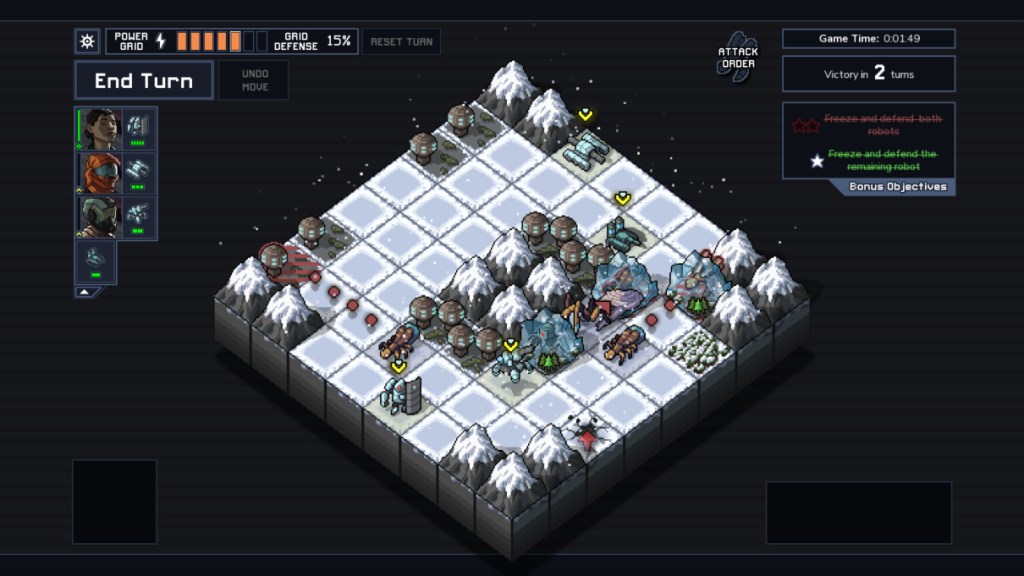I was reading Toasty’s excellent Dragon Quest restrospective, and never having played the games, I was surprised by his description of this 35 year old entry. Combat is always 1v1, there aren’t many actions to choose from, and numbers are low. I jumped on the RPG train a bit later, and got accustomed to damage in the thousands and games continuing to add mechanics and complexity. The weapon triangle of Fire Emblem, the sphere grid in Final Fantasy X, the sprawling customization of Battletech–all of these things add possibilities. At the same time, Dragon Quest sounded surprisingly modern in its approach, and I think we’ve come back around on the value of simplicity. To me, the most important thing a turn-based game needs to achieve is making every action feel meaningful. And the more complex systems you pile on, the harder this is the achieve.
The Weight of Choice
Turn-based games by their nature invite you to dwell on every choice. That’s the appeal. You can be an armchair general or face the difficult dilemmas of a cinematic hero. When your decisions have weight, this is incredibly compelling. But when a turn-based game asks you to make a trivial decision, it forces you to notice your time being wasted. And for me, nothing kills the fun of a game faster than feeling like it wastes my time.
The more mechanics and systems a game adds, the harder it is to make all of them matter. In the sloppiest cases, actions can simply be obsoleted by superior options. But even if all the possibilities are useful, you often get into specializations with situational uses. That anti-tank gunner sure is great . . . until the enemy attacks with infantry. The game also needs to build scaffolding to support its systems. This could be anything from more menus to a bigger field to play on. But often this means even more choices the game needs to be able to put weight on.
Fire Emblem, a quality grid tactics series that I’ve personally enjoyed, is an instructive example. There are a variety of different classes complete with class evolutions that can use multiple weapon types. There’s rock-paper-scissors triangle for weapons and magic to think about. You can deploy a dozen heroes on maps with hundreds of tiles and all sorts of topographic features. There’s a good bit of depth, and when it works it’s interesting to have options at your fingertips. But it also creates some fat. You often deploy across the map from your foe and spend multiple turns simply walking around before the real battle starts. Units can have nothing to do because they can’t use the right weapon.
This spills over into other aspects of the design. Fire Emblem is usually not very aggressive about pressuring the player. The complexity and scope can make the prospect of quick tactical shifts unwieldy, and the game has to account for that when pushing its pace. My experience with Fire Emblem was usually along the lines of breaching a series of fortified enemy positions by meticulously shuffling my warriors into place before beginning the assault. The showdown is exciting. The turns spent walking across the map and getting into position less so. And each move is multiple button presses: select character, select square, confirm. The mechanics simply don’t let you gloss over things. Plus, a good chunk of my team ends up hanging out on the sidelines because they don’t have the right skills to be useful. Cycling through the obvious and pointless options in a turn-based paradigm causes the pace of the battles to drag.

Less is More
Into the Breach, my favorite turn-based game, turns all of this on its head. You have 3 mechs on an 8×8 grid, each of which has one or two abilities. Deploy in the front row? You’ll be open to immediate attack, though maybe that’s what you want. The enemy plans its attack first, forcing you to respond to threats from turn 1. And you had better respond. 1 damage is massive when your units have 3 hp and important buildings can go down in a single hit. Battles only go for 5 turns, but new enemies arrive each turn. Even in the rare cases where you don’t use a mech’s attack, you can see where foes will emerge the next turn and simply choosing where to stand can be the difference between victory and defeat.
The experience is small in scope and your options are streamlined. But the result is that everything you do is vitally important. One wrong move could mean losing one of only three units, failing an objective, or even game over. Each decision feels worth thinking about and deserving of the attention the mechanics bring to it. There’s no getting to the good part. The whole game is the good part. For me, Into the Breach is the pinnacle of what turn-based gameplay can be.
And maybe it was there all along right under our noses. After all, even 35 years ago it sounds like Dragon Quest understood some things about making choices count.
Excellent write up, marra.
Into The Breach is an absolute masterclass in crotch-chaffingly tight game design and minimalism. It’s easily one of my favourite games.
Thanks for the plug too! Was unexpected, but greatly appreciated 🙂
LikeLike
Thanks, man. Your post was something of an inspiration for this too. Your evaluation of DQ and how its simplicity, even when that simplicity is often a product of its time, creates interesting choices and still holds up today got me thinking about how we trended away from that, and yet some of my favorite modern games, like Into the Breach, go back to it.
LikeLike